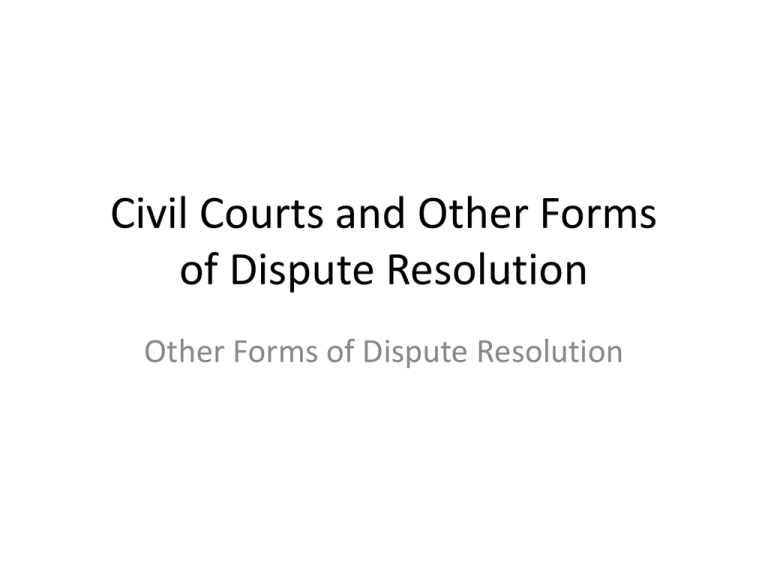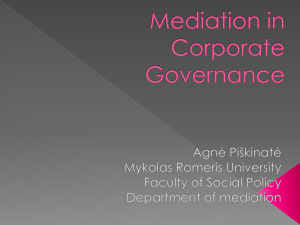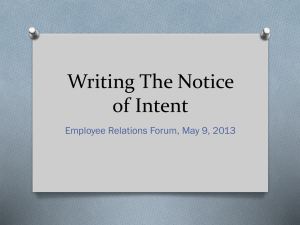Civil Courts and Other Forms of Dispute Resolution
advertisement

Civil Courts and Other Forms of Dispute Resolution Other Forms of Dispute Resolution Lesson Objectives • I will be able to state reasons why there is a need for other forms of dispute resolution • I will be able to describe the people involved in each of the other forms of dispute resolution • I will be able to outline the procedures in each of the other forms of dispute resolution • I will be able to allocate types of dispute to each form Topic 8 Alternative dispute resolution Introduction to ADR Alternative dispute resolution (ADR) has become increasingly popular. The civil court system is expensive and time consuming. Therefore, people often seek alternatives to court in order to resolve their disputes. The various methods of resolving disputes Method • Negotiation • Mediation Brief description • The parties themselves • The parties with the help of a neutral third party • Conciliation • As above, but a neutral third party plays an active role in suggesting a solution • Arbitration • The parties agree to let a third party make a binding decision • Litigation • The parties go to court (and therefore a judge) or tribunal (panel) NB all of the above except litigation are commonly referred to as ADR, or alternative methods of dispute resolution, i.e. alternative to litigation Tribunals Since the late 1940’s there has been a growth in parliamentary legislation affecting individuals in their private lives. These laws inevitably result it disputes, for example whether an individual is entitled to a particular state benefit. A system had to be constructed to allow these disputes to be resolved. The court system could not cope with the number of disputes so tribunals were created for each area, e.g. the Social Security Appeal Tribunal. In 1957, the Franks Committee on Tribunals reviewed how tribunals were working and recommended that tribunals should be based on, for example: • Independence (from Government) • Openness (all hearings should, if possible, be in public) • Accessibility ( so that all parties could understand the procedure involved, and legal representation was not essential) As a result of this Committee’s report, the Tribunals and Enquiries Act 1958 created the Council of Tribunals to review the running and workings of tribunals. The Council has 15 members, who observe cases and deal with complaints. The Council cannot insist on reforms, but may make recommendations. After a recommendation, the Government set up the Leggatt Committee in 2001, which advised that all tribunals should be dealt with under the Tribunals Service from April 2006. Types of dispute There are many tribunals but they may be classed as two main types: administrative and domestic. Administrative tribunals Administrative tribunals are set up by the government to allow citizens a way to challenge the decisions of the state. Examples include: • social security appeal tribunals • immigration appeal tribunals • mental health tribunals However, some administrative tribunals deal with disputes between individuals: •rent tribunals •Employment (formerly industrial) tribunals They are governed by the Tribunals and Enquiries Act 1992 and are supervised by the Queen’s Bench Division of the High Court. Domestic tribunals Domestic tribunals are used by professional bodies to discipline or to resolve disputes within the profession. For example, the Law Society governs solicitors and has the power to suspend or disbar a member for misconduct. The tribunal will apply the rules of the particular organisation to the dispute between the parties. Other examples include: •Solicitors Disciplinary Tribunal •Bar Council •General Medical Council •F.A. People involved • A tribunal is composed of three people. One will be legally qualified and the other two will be experienced in the area considered by the tribunal. • Tribunals vary in their procedures, with some being similar to a court trial. Not all tribunals have a route for appeal. • Generally, parties are encouraged to represent themselves and not use lawyers. The parties will attend, as will their witnesses. Procedure • The parties and their witnesses give evidence • All will be available for questioning by the other party and by the chairman and lay members • Not bound by strict rules of evidence and procedures that apply in the civil courts • Rules of precedent do not apply • Lawyer not needed for representation • Party can represent themselves, a friend, or someone with an understanding of their complaint such as a trade union member • Tribunals are free • If lawyer is used – very unlikely public funding will be available (exceptions are Lands Tribunal, Mental Health Review and Employment Appeals tribunal) • Unlike in civil courts, each party must meet their own legal costs regardless of who wins • Most tribunals are obliged to give reasons for their decisions, which has allowed for more decisions to be challenged on appeal • Tribunals must follow the rules of natural justice – time to prepare, fair hearing etc. Queen’s bench can reverse a decision if these rules have not been followed Lord Woolf Page 82 - Reform Tribunals: advantages and disadvantages Advantages • Tribunals prevent overloading of the courts • They hear six times the number of cases the courts hear • • • • • • • • • • • Cost effective Applicants are encouraged to represent themselves and not use lawyers Also, it is rare for an order of costs to be made, so applicants are not deterred from using a tribunal by the fear of a large bill if they lose Disadvantages • Lack of funding • If an applicant is not represented s/he has less chance of winning that those who are represented (28% cf 49% with a lawyer) • • • Speedy hearings Whereas judges can only change the law on very • • small areas of law “piecemeal” • Proactive reform, not reactive Simple procedure More informal than court • Most hear in private Flexible procedure • Chairman helps those who are not represented • Less speedy than before Due to the large volume of cases they hear Also because many tribunals sit part-time Procedural disadvantages For those without experience Even more complicated and difficult to find if more than one Act has to be consulted to find out what the law is Some tribunals do not have to give reasons for their decisions Some tribunals do not follow a system of precedent Is the chairman impartial? Types of tribunal •social security tribunals •rent tribunals •immigration tribunals •Mental Health Review Tribunal •employment tribunals Panel hearing case •Mostly a panel of three: chairman and two lay members with knowledge of the topic •Some tribunals have just one adjudicator Method of hearing Tribunals Control of tribunals •The courts - appeal system to Legal funding available for: put right incorrect decisions (judicial review proceedings) •Mental Health Review •The Council of Tribunals Tribunal reports but has little power •Employment Appeals Tribunal •Informal and in private •Except employment tribunals which are more formal, like a court, and open to the public Arbitration • Arbitration is where the parties refer the dispute to a third party, who will act as a judge and give a decision on the dispute, which is called an award. • The arbitrator will usually be a person with both legal and specialist knowledge of the subject matter of the dispute, for example, a surveyor may arbitrate in a building dispute. • Arbitration is governed by the Arbitration Acts 1979 and 1996, which sets out rules for arbitration and the various grounds for appeal from an arbitrator’s award. Types of dispute Most large commercial contracts will contain an arbitration cause allowing for arbitration to occur if a dispute arises under the contract. A number of trade and professional organisations offer an arbitration facility. E.g. ABTA Most disputes may use the arbitration process and the Chartered Institute of Arbitrators (CIA) can suggest and supply an independent arbitrator, if requested. If a claim is started at the Employment tribunal, a copy of the employee’s claim and employer’s response is sent automatically to the Advisory, Conciliation and Arbitration Service (ACAS). The ACAS representative is an expert in employment law and can, if the parties agree, act as an arbitrator. People involved The arbitrator is independent of the parties and is usually an expert in the area of the dispute. The parties may name a specific arbitrator in their contract or name a professional body that can appoint the arbitrator should a dispute arise. The parties will present their case to the arbitrator, which may involve witnesses. Procedure • The Arbitration Act 1996 states: • ‘The object of arbitration is to obtain the fair resolution of dispute by an impartial tribunal without unnecessary delay or expense.’ • The organisation ACAS (Arbitration, Conciliation and Advisory Service) uses this method to resolve employment disputes. • • • • • • • • • • • • • • • • • • Arbitration agreement must be in writing, but how the arbitration proceeds is open to the parties to agree Arbitration clauses may be inserted into contracts – Scott v Avery clause Clause will specify who is arbitrator, or the process for appointing one Court will refuse to deal with a case with this clause if it has not gone to arbitration first – e.g. ABTA – package holidays An agreement to go to arbitration can also be reached after a dispute has arisen The Act sets out the powers of the parties to shape the process according to their needs, together with the powers of the arbitrator Both parties and arbitrator agree hearing procedure together Hearing can be set at place of mutual convenience Private hearing Each party puts forward own arguments and evidence either in writing or orally Witnesses may be called to give evidence and cross-examined Arbitrator makes final decision (award), which IS BINDING on the parties E.g. arbitrator has the power to order one party to pay money to another Arbitration process is free, but arbitrator will charge a fee Although it is discouraged, parties are allowed to be represented by a lawyer There is no automatic right of appeal S.68 of the Arbitration Act allows for a High Court appeal if there is a ‘serious irregularity’ S.69 a party may appeal on a point of law that arises in the arbitration decision Arbitration • • • • • • • ADVANTAGES Parties choose their own arbitrator – i.e. lawyer, professional arbitrator or technical expert Questions of quality can be decided by an expert: no expense of calling expert witnesses Time & place to suit parties Flexible procedure Private: no publicity Low cost The award is normally final and enforceable through courts • • • • • DISADVANTAGES An unexpected legal point may arise that is unsuitable for a non-lawyer arbitrator If a professional arbitrator is used his fee may be high A formal hearing is expensive: witnesses giving evidence and representation by lawyers Rights of appeal are limited Delays for commercial and international arbitration with professional arbitrator and lawyers are nearly as great as courts’ delays Mediation Mediation is a process by which a third party acts as a messenger between the parties to assist in resolving the dispute. The parties do not have to meet and the mediator will pass on the offers, counter-offers and general comments between the parties. The mediator is to help the parties define the issues in dispute and the emphasis is on the parties themselves creating a solution. The mediator is not to act as advisor to either party, who must make their own judgements on the offers made. Mediators may be selected from mediation bodies such as the Centre for Dispute Resolution – approx. 300 trained mediators Types of dispute • The Family Law Act 1996 has encouraged separating couples to use mediation instead of court action. If a party wishes to obtain public funding for legal advice and representation then it will be a condition that mediation must first be attempted. • The mediation may cover disputes over children, property and finance. • There are now a growing number of mediation services aimed at resolving small disputes, E.g. West Kent Independent Mediation Service offers a free service from trained voluntary mediators to try to resolve neighbour disputes over noise and boundaries. People involved The mediator will organise the mediation at a time and place convenient to all parties. The parties attend with legal advisors (if any). The mediator will pass on information from one party to another. The parties may be in separate rooms from each other if they prefer. Procedure • • • • • • • • • • • Private and neutral setting Put forward position, followed by private meetings between the mediator and each party in turn Mediator acts as a ‘go-between’, whereby the two parties in dispute communicate and negotiate through the mediator Mediator remains neutral and does not suggest solutions and cannot force settlement Mediator encourages the two parties to reach an agreement Each party may be legally represented, but this is discouraged Each party must meet their own legal costs but public funding is available for family mediation Witnesses are rarely involved If the parties reach an agreement then this may be written down and , if the parties agree, the agreement becomes legally binding The agreement is enforceable by the civil courts should either party fail to follow the terms of the agreement If no agreement is reached, the matter may be taken to court or a tribunal Conciliation • A conciliator discusses the dispute with the parties and encourages them to find a solution upon which they both agree. • Most disputes involving employment try this method before the case goes to an employment tribunal. • It is important for the parties to realise that the conciliator is neutral and is not acting as their representative Types of dispute • The organisation ACAS offers this service to encourage an employer and employee to come to an agreement. • In a tribunal case ACAS will be sent a copy of the employee's claim and employer’s response. • The ACAS representative is an expert in employment law and, with the parties’ agreement, can act as a conciliator in the dispute People involved The conciliator will organise the conciliation at a time and place convenient to all parties. The parties attend with legal advisors (if any). The conciliation will proceed as mediation except for the conciliator’s added powers of intervention. Procedure • Similar to mediation • Conciliator and parties will meet and the conciliator will listen to the grievances and will make suggestions how the problem can be resolved • If the parties agree then the agreement may be made legally enforceable as for mediation • If no agreement is reached, the mater may be taken to court or a tribunal Negotiation The parties involved in a dispute discuss the problem between themselves, with or without a lawyer present, to try to find a solution. Can be face-to-face, by letter, telephone, email, text, etc. If either or both of the parties are legally represented, the lawyer(s) will continue to negotiate throughout their involvement. Many cases are settled on the morning of a court hearing. Types of dispute Any dispute may be resolved by negotiation. Mediation and conciliation are forms of negotiation, but using third parties to assist in the process. Low-key disputes are best resolved by negotiation without expensive court action. A neighbour disagreement or a dispute between an electrician and the homeowner are examples of when a negotiated settlement would be appropriate. People involved The only people involved are the parties themselves of their representatives if they have one. Procedure • No fixed procedure • Often a meeting will commence with each party stating their position • Successful negotiation requires focus on the issues not personalities. It will also require compromise • No costs involved. If agreement not reached then the parties may instruct lawyers • Lawyers will encourage clients to reach an agreement without resorting to the court. • Cheaper without court and lawyers Advantages of using ADR • costs less • speed • less formal than court • less adversarial Disadvantages of using ADR • under used • lack of precedents • unequal bargaining power










